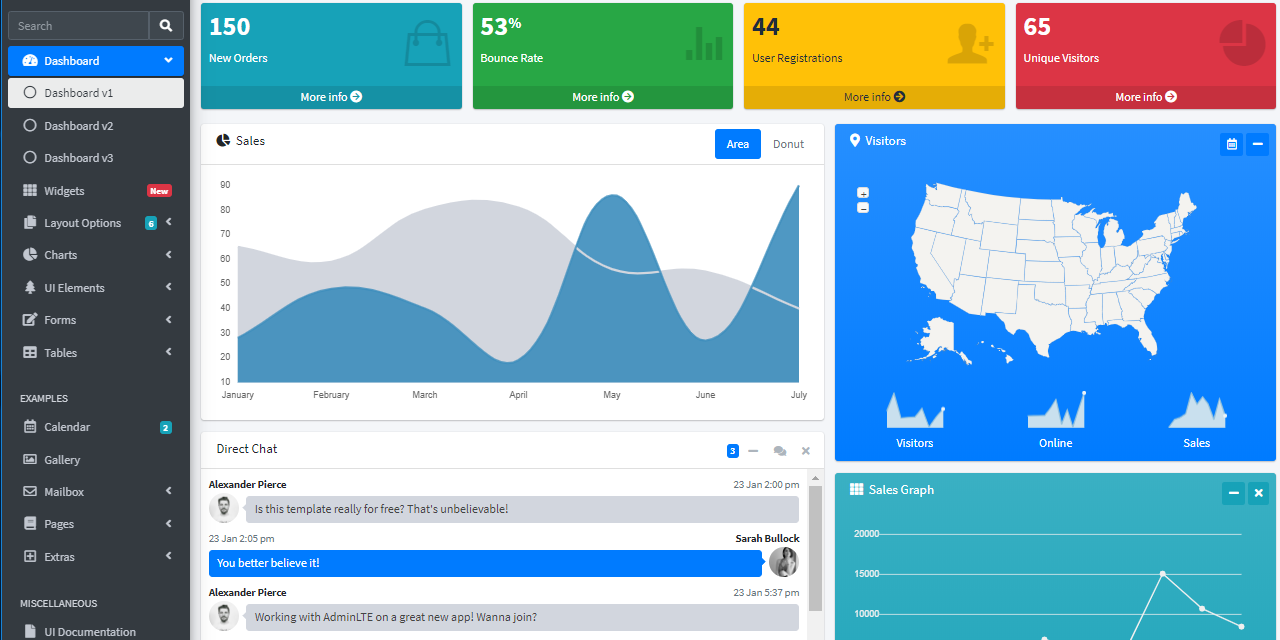Open-source Flask/Jinja Template generated by the AppSeed platform on top of AdminLTE, the famous dashboard template. For newcomers, Jinja is a template language used by frameworks like Flask, Bottle and Django to render HTML files in a secure, smart way. AdminLTE Jinja Template is basically a super simple Flask codebase without database, or other hard dependencies. Project might be used to code a future Flask project on top or integrate the design into a legacy project.
- Up-to-date dependencies: Flask 2.0.1
- SCSS compilation via Gulp
- UI Kit: AdminLTE by ColorLib
- Render Engine: Flask / Jinja2
- Deployment scripts: Docker, Gunicorn/Nginx, HEROKU
- Support via Github (issues tracker) and Discord.
Links
- AdminLTE Flask - version with database, ORM and deployment scripts
- AdminLTE Django - open-source Django version of AdminLTE
Quick Start in Docker
Get the code
$ git clone https://github.com/app-generator/jinja-adminlte.git
$ cd jinja-adminlteStart the app in Docker
$ docker-compose pull # download dependencies
$ docker-compose build # local set up
$ docker-compose up -d # start the app Visit http://localhost:85 in your browser. The app should be up & running.
$ # Clone the sources
$ git clone https://github.com/app-generator/jinja-adminlte.git
$ cd jinja-adminlte
$
$ # Virtualenv modules installation (Unix based systems)
$ virtualenv env
$ source env/bin/activate
$
$ # Virtualenv modules installation (Windows based systems)
$ # virtualenv env
$ # .\env\Scripts\activate
$
$ # Install requirements
$ pip3 install -r requirements.txt
$
$ # Set the FLASK_APP environment variable
$ (Unix/Mac) export FLASK_APP=run.py
$ (Windows) set FLASK_APP=run.py
$ (Powershell) $env:FLASK_APP = ".\run.py"
$
$ # Set up the DEBUG environment
$ # (Unix/Mac) export FLASK_ENV=development
$ # (Windows) set FLASK_ENV=development
$ # (Powershell) $env:FLASK_ENV = "development"
$
$ # Run the Jinja Template
$ # --host=0.0.0.0 - expose the app on all network interfaces (default 127.0.0.1)
$ # --port=5000 - specify the app port (default 5000)
$ flask run --host=0.0.0.0 --port=5000
$
$ # Access the UI in browser: http://127.0.0.1:5000/The project has a simple structure, represented as bellow:
< PROJECT ROOT >
|
|-- app/
| |-- static/
| | |-- <css, JS, images> # CSS files, Javascripts files
| |
| |-- templates/
| | |
| | |-- includes/ # Page chunks, components
| | | |
| | | |-- navigation.html # Top bar
| | | |-- sidebar.html # Left sidebar
| | | |-- scripts.html # JS scripts common to all pages
| | | |-- footer.html # The common footer
| | |
| | |-- layouts/ # App Layouts (the master pages)
| | | |
| | | |-- base.html # Used by common pages like index, UI
| | | |-- base-fullscreen.html # Used by auth pages (login, register)
| | |
| | |-- accounts/ # Auth Pages (login, register)
| | | |
| | | |-- login.html # Use layout `base-fullscreen.html`
| | | |-- register.html # Use layout `base-fullscreen.html`
| | |
| | |-- home/ # UI Kit Pages
| | |-- index.html # Index page
| | |-- 404-page.html # 404 page
| | |-- *.html # All other pages
| |
| views.py # Application Routes
|
|-- Dockerfile # Deployment
|-- docker-compose.yml # Deployment
|-- gunicorn-cfg.py # Deployment
|-- nginx # Deployment
| |-- appseed-app.conf # Deployment
|
|-- requirements.txt
|-- run.py
|
|-- ************************************************************************To recompile SCSS files, follow this setup:
Step #1 - Install tools
Step #2 - Change the working directory to assets folder
$ cd app/static/assetsStep #3 - Install modules (this will create a classic node_modules directory)
$ npm install
// OR
$ yarnStep #4 - Edit & Recompile SCSS files
$ gulp scssThe generated file is saved in static/assets/css directory.
The project comes with a basic configuration for Docker, Gunicorn, and Waitress.
Gunicorn 'Green Unicorn' is a Python WSGI HTTP Server for UNIX.
Install using pip
$ pip install gunicornStart the app using gunicorn binary
$ gunicorn --bind 0.0.0.0:8001 run:app
Serving on http://localhost:8001Visit http://localhost:8001 in your browser. The app should be up & running.
Waitress (Gunicorn equivalent for Windows) is meant to be a production-quality pure-Python WSGI server with very acceptable performance. It has no dependencies except ones that live in the Python standard library.
Install using pip
$ pip install waitressStart the app using waitress-serve
$ waitress-serve --port=8001 run:app
Serving on http://localhost:8001Visit http://localhost:8001 in your browser. The app should be up & running.
- Flask Framework - The official website
AdminLTE Jinja/Flask - Provided by AppSeed App Generator.
